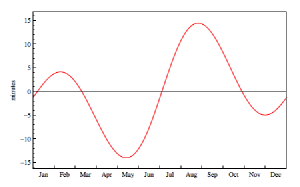Post
Equation of Time
28 September 2012
In our modern age we measure time by clocks calibrated to an international standard. With the exception of the occasional leap second, each day is exactly 24 hours long. So you might figure that the time between noon on Monday and noon on Tuesday is likewise 24 hours, but things are not quite so simple.
If we consider “noon” to be the time at which the sun is highest in the sky (which we can measure by a sundial), rather than “when the clock reads 12,” then the time between successive noons is not quite 24 hours. Relative to our clock, our sundial will seem to run a bit fast on some days, and a bit slow on others. To relate sundial time to clock time, we therefore need a correction known as the equation of time. I’ve plotted this equation in the figure below, and it shows the correction factor needed at various times of the year.
 Brian Koberlein
Brian KoberleinThe reason for this correction is because of two factors. The first is that Earth’s orbit is not quite a perfect circle, but rather a slight ellipse. For part of the year it is a bit closer to the Sun than its average distance, and for part of the year it is a bit further away. While the Earth rotates on its axis at essentially a constant rate, the Earth’s speed around the Sun is not constant. Instead it orbits a bit faster when it is closer to the sun and slower when farther away. Because the Earth is orbiting the Sun, the Earth has to rotate about a degree more than 360 degrees go from noon to noon. On days when it moves faster it has to rotate a bit more than that, and on days when it moves more slowly it has to rotate a bit less.
The second factor is due to the tilt of the Earth’s axis. Because of this tilt the Sun appears higher in the sky during the Summer months and lower in the Winter months. This means from one noon to the next the Sun is a bit higher or a bit lower depending on the season. That daily shift means the time at which the Sun is highest in the sky (noon) is a bit early or a bit late.
The combination of these two factors creates the equation of time you see above. It is the ebb and flow of the celestial clock as our home rounds the Sun.